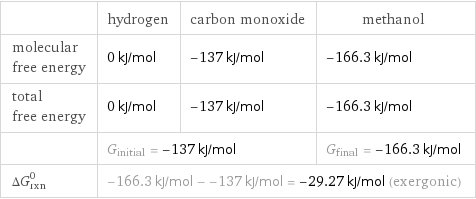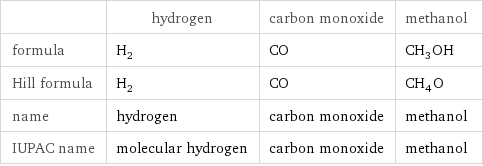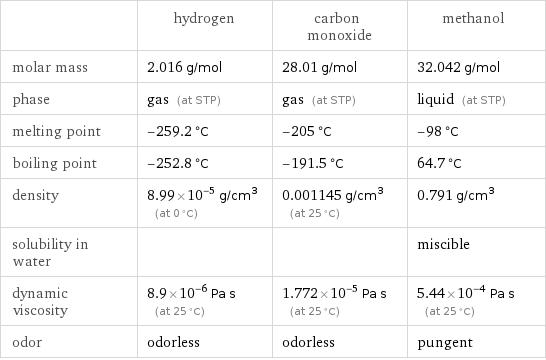Input interpretation

H_2 hydrogen + CO carbon monoxide ⟶ CH_3OH methanol
Balanced equation

Balance the chemical equation algebraically: H_2 + CO ⟶ CH_3OH Add stoichiometric coefficients, c_i, to the reactants and products: c_1 H_2 + c_2 CO ⟶ c_3 CH_3OH Set the number of atoms in the reactants equal to the number of atoms in the products for H, C and O: H: | 2 c_1 = 4 c_3 C: | c_2 = c_3 O: | c_2 = c_3 Since the coefficients are relative quantities and underdetermined, choose a coefficient to set arbitrarily. To keep the coefficients small, the arbitrary value is ordinarily one. For instance, set c_2 = 1 and solve the system of equations for the remaining coefficients: c_1 = 2 c_2 = 1 c_3 = 1 Substitute the coefficients into the chemical reaction to obtain the balanced equation: Answer: | | 2 H_2 + CO ⟶ CH_3OH
Structures

+ ⟶
Names

hydrogen + carbon monoxide ⟶ methanol
Reaction thermodynamics
Enthalpy

| hydrogen | carbon monoxide | methanol molecular enthalpy | 0 kJ/mol | -110.5 kJ/mol | -238.7 kJ/mol total enthalpy | 0 kJ/mol | -110.5 kJ/mol | -238.7 kJ/mol | H_initial = -110.5 kJ/mol | | H_final = -238.7 kJ/mol ΔH_rxn^0 | -238.7 kJ/mol - -110.5 kJ/mol = -128.2 kJ/mol (exothermic) | |
Gibbs free energy

| hydrogen | carbon monoxide | methanol molecular free energy | 0 kJ/mol | -137 kJ/mol | -166.3 kJ/mol total free energy | 0 kJ/mol | -137 kJ/mol | -166.3 kJ/mol | G_initial = -137 kJ/mol | | G_final = -166.3 kJ/mol ΔG_rxn^0 | -166.3 kJ/mol - -137 kJ/mol = -29.27 kJ/mol (exergonic) | |
Entropy

| hydrogen | carbon monoxide | methanol molecular entropy | 115 J/(mol K) | 198 J/(mol K) | 126.8 J/(mol K) total entropy | 230 J/(mol K) | 198 J/(mol K) | 126.8 J/(mol K) | S_initial = 428 J/(mol K) | | S_final = 126.8 J/(mol K) ΔS_rxn^0 | 126.8 J/(mol K) - 428 J/(mol K) = -301.2 J/(mol K) (exoentropic) | |
Equilibrium constant
![Construct the equilibrium constant, K, expression for: H_2 + CO ⟶ CH_3OH Plan: • Balance the chemical equation. • Determine the stoichiometric numbers. • Assemble the activity expression for each chemical species. • Use the activity expressions to build the equilibrium constant expression. Write the balanced chemical equation: 2 H_2 + CO ⟶ CH_3OH Assign stoichiometric numbers, ν_i, using the stoichiometric coefficients, c_i, from the balanced chemical equation in the following manner: ν_i = -c_i for reactants and ν_i = c_i for products: chemical species | c_i | ν_i H_2 | 2 | -2 CO | 1 | -1 CH_3OH | 1 | 1 Assemble the activity expressions accounting for the state of matter and ν_i: chemical species | c_i | ν_i | activity expression H_2 | 2 | -2 | ([H2])^(-2) CO | 1 | -1 | ([CO])^(-1) CH_3OH | 1 | 1 | [CH3OH] The equilibrium constant symbol in the concentration basis is: K_c Mulitply the activity expressions to arrive at the K_c expression: Answer: | | K_c = ([H2])^(-2) ([CO])^(-1) [CH3OH] = ([CH3OH])/(([H2])^2 [CO])](../image_source/1472b1b87e98a79dd352f0717575a7f6.png)
Construct the equilibrium constant, K, expression for: H_2 + CO ⟶ CH_3OH Plan: • Balance the chemical equation. • Determine the stoichiometric numbers. • Assemble the activity expression for each chemical species. • Use the activity expressions to build the equilibrium constant expression. Write the balanced chemical equation: 2 H_2 + CO ⟶ CH_3OH Assign stoichiometric numbers, ν_i, using the stoichiometric coefficients, c_i, from the balanced chemical equation in the following manner: ν_i = -c_i for reactants and ν_i = c_i for products: chemical species | c_i | ν_i H_2 | 2 | -2 CO | 1 | -1 CH_3OH | 1 | 1 Assemble the activity expressions accounting for the state of matter and ν_i: chemical species | c_i | ν_i | activity expression H_2 | 2 | -2 | ([H2])^(-2) CO | 1 | -1 | ([CO])^(-1) CH_3OH | 1 | 1 | [CH3OH] The equilibrium constant symbol in the concentration basis is: K_c Mulitply the activity expressions to arrive at the K_c expression: Answer: | | K_c = ([H2])^(-2) ([CO])^(-1) [CH3OH] = ([CH3OH])/(([H2])^2 [CO])
Rate of reaction
![Construct the rate of reaction expression for: H_2 + CO ⟶ CH_3OH Plan: • Balance the chemical equation. • Determine the stoichiometric numbers. • Assemble the rate term for each chemical species. • Write the rate of reaction expression. Write the balanced chemical equation: 2 H_2 + CO ⟶ CH_3OH Assign stoichiometric numbers, ν_i, using the stoichiometric coefficients, c_i, from the balanced chemical equation in the following manner: ν_i = -c_i for reactants and ν_i = c_i for products: chemical species | c_i | ν_i H_2 | 2 | -2 CO | 1 | -1 CH_3OH | 1 | 1 The rate term for each chemical species, B_i, is 1/ν_i(Δ[B_i])/(Δt) where [B_i] is the amount concentration and t is time: chemical species | c_i | ν_i | rate term H_2 | 2 | -2 | -1/2 (Δ[H2])/(Δt) CO | 1 | -1 | -(Δ[CO])/(Δt) CH_3OH | 1 | 1 | (Δ[CH3OH])/(Δt) (for infinitesimal rate of change, replace Δ with d) Set the rate terms equal to each other to arrive at the rate expression: Answer: | | rate = -1/2 (Δ[H2])/(Δt) = -(Δ[CO])/(Δt) = (Δ[CH3OH])/(Δt) (assuming constant volume and no accumulation of intermediates or side products)](../image_source/ce746b3589d9db8eb6eb0e501e043086.png)
Construct the rate of reaction expression for: H_2 + CO ⟶ CH_3OH Plan: • Balance the chemical equation. • Determine the stoichiometric numbers. • Assemble the rate term for each chemical species. • Write the rate of reaction expression. Write the balanced chemical equation: 2 H_2 + CO ⟶ CH_3OH Assign stoichiometric numbers, ν_i, using the stoichiometric coefficients, c_i, from the balanced chemical equation in the following manner: ν_i = -c_i for reactants and ν_i = c_i for products: chemical species | c_i | ν_i H_2 | 2 | -2 CO | 1 | -1 CH_3OH | 1 | 1 The rate term for each chemical species, B_i, is 1/ν_i(Δ[B_i])/(Δt) where [B_i] is the amount concentration and t is time: chemical species | c_i | ν_i | rate term H_2 | 2 | -2 | -1/2 (Δ[H2])/(Δt) CO | 1 | -1 | -(Δ[CO])/(Δt) CH_3OH | 1 | 1 | (Δ[CH3OH])/(Δt) (for infinitesimal rate of change, replace Δ with d) Set the rate terms equal to each other to arrive at the rate expression: Answer: | | rate = -1/2 (Δ[H2])/(Δt) = -(Δ[CO])/(Δt) = (Δ[CH3OH])/(Δt) (assuming constant volume and no accumulation of intermediates or side products)
Chemical names and formulas

| hydrogen | carbon monoxide | methanol formula | H_2 | CO | CH_3OH Hill formula | H_2 | CO | CH_4O name | hydrogen | carbon monoxide | methanol IUPAC name | molecular hydrogen | carbon monoxide | methanol
Substance properties

| hydrogen | carbon monoxide | methanol molar mass | 2.016 g/mol | 28.01 g/mol | 32.042 g/mol phase | gas (at STP) | gas (at STP) | liquid (at STP) melting point | -259.2 °C | -205 °C | -98 °C boiling point | -252.8 °C | -191.5 °C | 64.7 °C density | 8.99×10^-5 g/cm^3 (at 0 °C) | 0.001145 g/cm^3 (at 25 °C) | 0.791 g/cm^3 solubility in water | | | miscible dynamic viscosity | 8.9×10^-6 Pa s (at 25 °C) | 1.772×10^-5 Pa s (at 25 °C) | 5.44×10^-4 Pa s (at 25 °C) odor | odorless | odorless | pungent
Units
